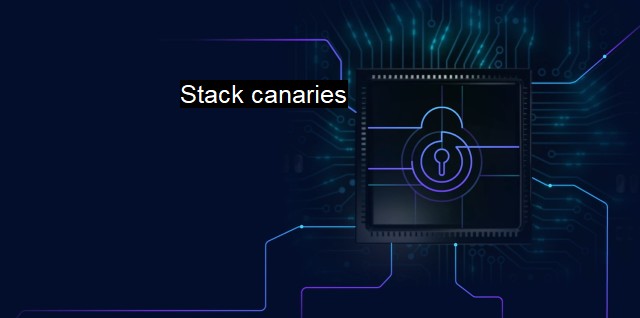What are Stack canaries?
Enhancing Security Measures: Understanding Stack Canaries - A Prevention Mechanism Against Buffer Overflow Attacks
"Stack Canaries" is a term used in cybersecurity to refer to a specific technique used for preventing a common hacking exploit known as a buffer overflow attack. Stack Canaries, named after the infamous "canary in a coal mine" analogy, are used by programmers to catch vulnerabilities in a system before they can be maliciously exploited. Just like miners once used canaries to warn of harmful gases daedal, Stack Canaries warn programmers of a potential buffer overflow that could lead to unauthorized, malintended access.A buffer overflow is a method used by hackers to exploit a weakness in a computer program, often to rewrite the program's memory. Buffers are designed to hold a set amount of data, but if they're sent more data than they can handle, it spills over into adjacent memory locations. This is known as 'overflowing', and can cause serious cybersecurity issues, enabling attackers to execute arbitrary code, crash the system, and gain unauthorized access.
In order to guard against such exploitations, Stack Canaries were introduced. These are small, randomized values placed on the stack, right before the control data. By placing these values on the stack, just before essential control data is expected, any attempt to overwrite this data and return addresses (a crucial first step in a buffer overflow attack) could be halted in its tracks.
The function of Stack Canaries is simple: whenever a function is being called upon, a Stack Canary value is created and placed into the memory. More specifically, immediately after the memory reserved for local variables. Before the function ends, the system checks the Canary value. If it remains the same, the function ends normally; if it has changed, the system assumes a buffer overflow attack was initiated and raises an alarm, terminating the function instantly.
Turning to the inner workings of Stack Canaries, these dynamic mechanisms remain highly effective due to their randomness. there are commonly four different types of Stack Canaries: Terminate-Canary, Random Canary, Random XOR Canary, and Null-Canary. Each has its own advantages and specific scenarios where they can offer superior protection.
Terminate-Canaries are those containing a Null character and are used to interrupt string operations, which are common tactics used to induce buffer overflow. Random Canaries, on the other hand, rely purely on randomness and unpredictability, making it harder for attackers to guess the proper value. This prevents the direct exploitation of the canaries.
Random XOR Canaries combine the advantages of the above two: a Random Canary is created, parts of which are then used to form a Terminate-Canary. Lastly, a Null-Canary is typically a series of null factors, also triggering string operations in a hacker's endeavor to breach security.
While Stack Canaries are effective at thwarting the most common forms of buffer overflow attack, they are not foolproof. Sophisticated invaders employ techniques such as Return Oriented Programming to write malicious code with small chunks valid code that could still bypass the checks of a Stack Canary.
Another drawback of Stack Canaries is the additional system resources and performance time they require, leading to slowed processing speeds in some instances. There's also the fact that they are unable to detect overflows within the same function, rendering them ineffective against such attacks.
Despite potential limitations in certain scenarios, Stack Canaries remain an integral part of modern cybersecurity standards, especially guarding against buffer overflow exploits. They serve as a preemptive alarm system, alerting the higher-level routines when someone tries tampering with the memory layout. companies aspiring for ultimate data protection must consider employing a more holistic and layered approach to security, incorporating multiple defense measures alongside Stack Canaries.

Stack canaries FAQs
What are stack canaries?
Stack canaries are a security mechanism used by operating systems to detect buffer overflow attacks. They are values placed on the stack between local variables and the return address.How do stack canaries protect against buffer overflow attacks?
When a function is called, the stack canary value is set to a random number. If a buffer overflow occurs during the function's execution, the canary value is overwritten. This change is detected when the function returns, and an error is generated, preventing the attack from succeeding.Are all operating systems configured to use stack canaries?
No, not all operating systems are configured to use stack canaries by default. Some systems may require manual configuration to enable this security feature. However, most modern operating systems, including Windows and Linux, have support for stack canaries.Are there any limitations to using stack canaries?
Although stack canaries can be effective in detecting buffer overflow attacks, they are not foolproof. Skilled attackers can find ways to bypass the protection provided by stack canaries. Additionally, certain programming languages or code optimization techniques may make it difficult to use stack canaries effectively.| | A | | | B | | | C | | | D | | | E | | | F | | | G | | | H | | | I | | | J | | | K | | | L | | | M | |
| | N | | | O | | | P | | | Q | | | R | | | S | | | T | | | U | | | V | | | W | | | X | | | Y | | | Z | |
| | 1 | | | 2 | | | 3 | | | 4 | | | 7 | | | 8 | | |||||||